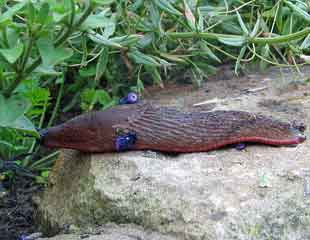

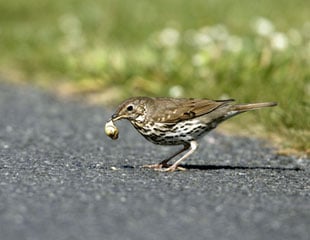
How to get rid of slugs and snails
As soon as spring arrives, so do the slugs and snails. Nasty creatures which can shred a Hosta or tender Delphinium overnight. During the spring and summer slugs emerge, especially during spells of wet and warm weather which will draw them out. Slugs and snails are the No 1 Garden Enemy, with an ability to consume a vast amount of tender plant growth disproportionate to their modest size. They are a problem in the garden and veg plot, how they just love lettuce. It's a war with the slimy creatures.
Most slugs and snails are nocturnal, which means night time is a good time to spot and dispatch them. Slugs and snails lay their eggs in the soil where they remain over winter, growing into mature slugs.
There are several tried and tested ways to get rid of slugs and snails and you may find more than one method is necessary. Unfortunately, both slugs and snails are hermaphrodites, which means they can reproduce alone and some slugs may lay hundreds of eggs at one go and several times a year. So there is no shortage of slugs.
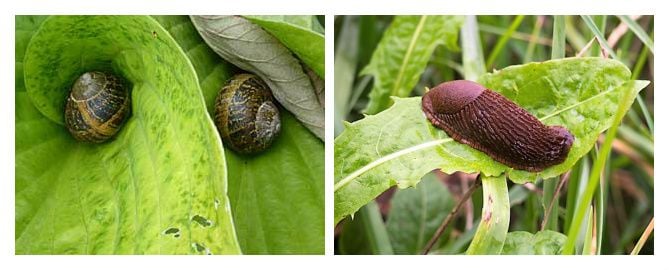
- Nematodes
- Beer Traps
- Picking and dispatching.
- Slug Pellets
- Barrier method
- Raised Beds
- Thrushes and Frogs, the Gardener's friend.
- Plant Slug resistant plants.
Before slugs, a word about snails
Snails are a tricky pest to discourage and one of the best ways is to encourage these, Thrushes. Unlike many birds which feed on seeds, thrushes prefer snails that are a tasty morsel. They will search them out and break open the shells on a convenient stone and eat the snails.
The best way to encourage thrushes into the garden, as with all wildlife, is to reduce the use of any chemicals and provide food and shelter. For thrushes, berry-bearing shrubs and trees are ideal food and will bring thrushes into the garden.
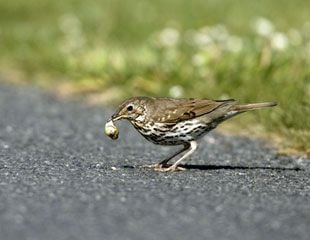
Best ways to get rid of slugs
Beer Traps
An easy DIY and cheap means of attacking the slug population is to set up beer traps using any bargain price beer or lager.
Beer traps are a non-invasive way of killing slugs and my favourite way of getting rid of slugs and snails, effective but smelly! You can buy specially manufactured traps with a lid, so that the summer rain does not dilute the beer, and reduce the allure of the trap. The beer attracts the slimy slugs which slide into the traps and drown. Raise the trap about 5cms above the soil so the beneficial insects do not fall in. You can also make your own recycling margarine and yogurt tubs.
Beer traps are effective; the downside is that slug traps need emptying regularly and replenished with fresh beer, and that’s when the smell gets to you. Without being too descriptive, combine beer with dead slugs and a few days fermentation. Not for the faint-hearted but effective and no pesticides.
Nematodes
Nematodes are an effective method of killing slugs and snails, but they require some hard work because they have to be watered into the soil, just as it is warming up, and then repeated 6 weeks later. The packets can also be a bit expensive, retailing at around £14.00 for around 40m2 at 2021 prices. If you use repeatedly, year after year, over time, the slug and snail population will reduce as you stop them from re populating. If the prospect of watering Nematodes over your garden is too much to contemplate and too expensive, apply only to the areas most at risk, say the salad area of the vegetable plot or around a Hostas bed. Also, if you have a big problem with slugs and snails, you could use Nematodes for the first 2-3 years to reduce the population, and then move to one of the cheaper methods listed below.
Nematodes come with instructions to mix them with water for the correct concentration. To be effective, the soil temperature must be at least 5 degrees. Once purchased Nematodes need to be refrigerated and they usually have a use by date, so it's best to order or buy them when you are ready to use them and you expect the soil will be warm enough.
Nematodes are an effective way of getting rid of slugs and snails, and it is an organic method of killing slugs. Slug nematodes live in the soil after watering in and are microscopic transparent worms which feed and multiply inside the slug. An infected slug stops feeding within 3 to 5 days and the nematodes multiply inside the slug. When it decomposes, a new generation of nematodes emerges.
The slugs which attack potatoes live in the soil underground, which means slug pellets are ineffective. Nematodes are the only way to combat slugs eating potatoes.
Slug pellets
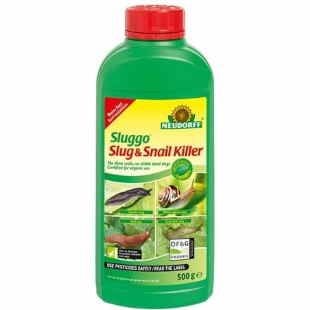
If you garden organically, slug pellets have had a bad press and if you are growing vegetables, the fewer chemicals, the better. Traditional Slug pellets contain 3% metaldehyde.
Slug pellets are widely used, but be aware they are toxic to domestic pets, wild animals and birds and no good for gardeners either.
Organic slug pellets are now widely available and Which? Gardening in 2011 (the consumer champion) tested 3 types of slug pellets. The first two metaldehyde based and the third organic based on ferric phosphate and discerned no difference in performance and so let's go for the organic pellets. Pellets are effective when spread around susceptible plants.
Also, to bang the organic drum, the Pesticides Usage Survey Group 2000 estimated that 400 billion pellets are sprinkled on gardens annually, and they get into the watercourse and from there into drinking water. I have used various organic slug pellets including this product which is certified organic and does the job.
Picking and Dispatching
On a warm summer evening it's not unusual to find many slugs and snail sliding around munching on precious plants, especially after it has rained. Slugs and snails tend to be more active after dark, and so a torch is helpful to highlight them for the favoured way to pick them off, (unwanted BBQ tongs are good for this) and then drop the slug into jar with beer or water to drown and put a lid on the container or they will escape. Pick and dispatch.
Alternatively, you can skewer them on the spot, depending on your squeamish count, but this method is quite satisfying and definitely kills them.
Barrier Methods
Slugs and snails do not like to travel over sharp prickly surfaces. As a result many of the slug and snail deterrents on the market are designed to form a barrier over which the slug or snail will be reluctant to slide across. Sharp gravel and egg shells work to a limited extent. There are propriety commercial barrier methods such as 'Slug gone' said to be a natural wool barrier, 'Slug be gone' natural pellets; Neudorff Sluggo Slug and Snail Killer organic and effective.
Three Cheers for Raised Beds
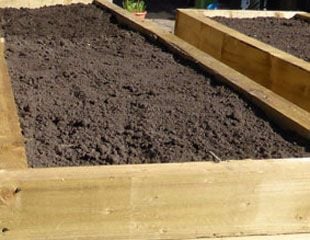
One of the most difficult areas to have slugs and snails is in the vegetable plot. The image left is the these raised beds in my garden which are constructed from quite rough wooden railway sleepers, and the roughness of the wood deters the slugs and snails from climbing up them.
These beds are also higher which is a further deterrent. Barrier methods will work with slugs and snails, but this type of raised bed is one of the best vertical barriers and very effective. I would really recommend this construction for raised beds, even growing lettuces they are slug and snail free.
Attract wildlife: Thrushes and Frogs, the gardener's friend
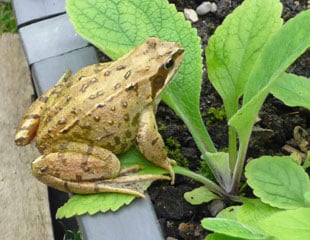
It is absolutely correct that Thrushes love snails; in with the Thrushes and out with the snails. Thrushes will seek out the snails, rummaging around in the borders and undergrowth until they find a tasty snail morsel which they will pick up and carry over to a smashing stone. Thrushes often use the same stone and will hurl the snail onto the stone till its shell cracks, and then snack on it. Nature is brutal, but more Thrushes means fewer snails and better looking Hostas.
Thrushes like gardens with food, so in addition to snails, shrubs with berries such as Cotoneaster horizontalis, Ivy, native Rowan (Sorbus aucuparia) Pyracantha, and Berberis darwinii are a few suggestions.
Frogs will also eat small snails and slugs and can be encouraged into the garden by the presence of water in a pond or boggy area and they also like wood piles. If you have no room for a pond, create a suitable habitat choosing damp shady area and plant with shade loving plants such as Ferns, astilbes, and Hosta to make an area frog friendly although this one in the image left joined me at the veg plot for a spot of slug spotting.
There are other predators of slugs some types of beetle, slow worms, hedgehogs and toads. Thrushes will take the large snails but Black birds and Mistle thrushes will take smaller slugs, so the more wildlife in the garden, the better.
Both slugs and snails reproduce by laying eggs which you can find in the border as small white spherical eggs. They are often in the soil and disturbed by digging.
How to rescue a slug eaten plant
If the slugs have munched a bedding plant, don’t despair. If the plant is not too badly eaten, you can dig it up and rehabilitate in a place of safety away from the slug. Often, it will grow back and later you can plant it back out again.
The plant in the first image below has been badly chewed by slugs, and the second image is the same rejuvenating back to life ready for planting out again. If slugs have chewed the plant, especially bedding plants, many of which they relish, dig up and put into a pot. Place somewhere safe, such as a greenhouse, under glass, where you can keep an eye on it and give it two /three weeks in a recovery and it will regrow. Check out also slug resistant bedding plants.

Which plants do slugs love and hate?
If you have a serious problem with slugs and snails, you can modify your planting so that the plants in your garden are less attractive to slugs. Some plants are just slug magnets, to name a few: Hosta (obviously) (although there are some listed above which are "slug resistant" ) new Delphinium shoots, Beans, lettuce, Potato tubers, sweet peas, French Marigolds, Dahlia and Lobelia cardinalis for starters. I once had a lovely scarlet Lobelia cardinalis, gracing the edge of a pond, which disappeared overnight consumed by slugs. Slugs are also keen on shoots from a newly planted Clematis, which means when planting Clematis, if you have a slug problem, it is best to protect until the climber gets established.
Equally, there are plants that slugs and snails dislike, many of the herbs Rosemary, Sage, Thyme, Lavender and silver leaved or hairy leaved plants. Lots of the popular plants such as Penstemon, Astilbe, Crocosmia, Ornamental grasses, Sedum, anything with tough woody stems and aromatic leaves are not for the slugs. Slugs have no interest in Ferns, Hydrangeas, Japanese Anemones, Poppies (of all types) Geraniums. There are lots to choose from. Slug resistant plants.
